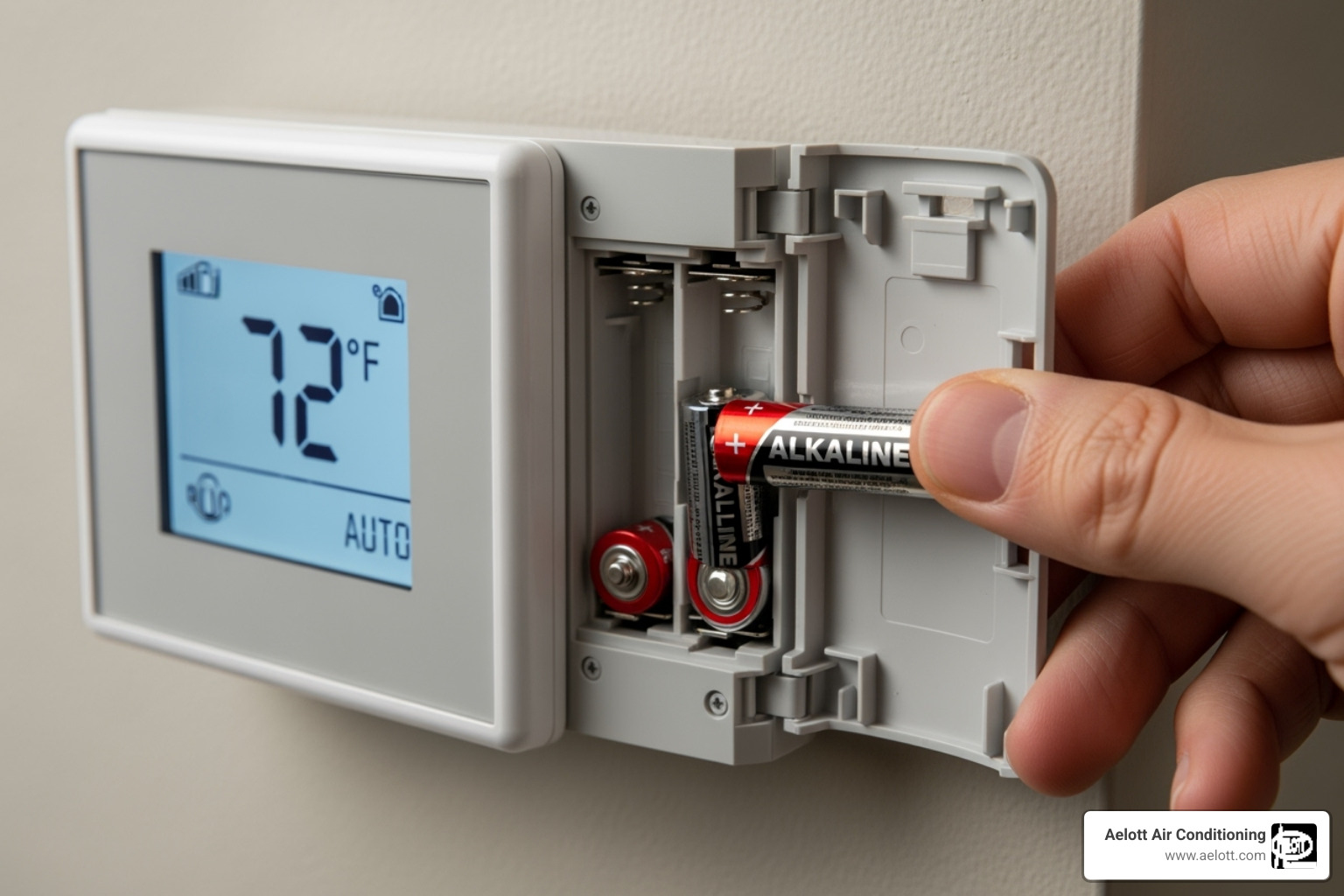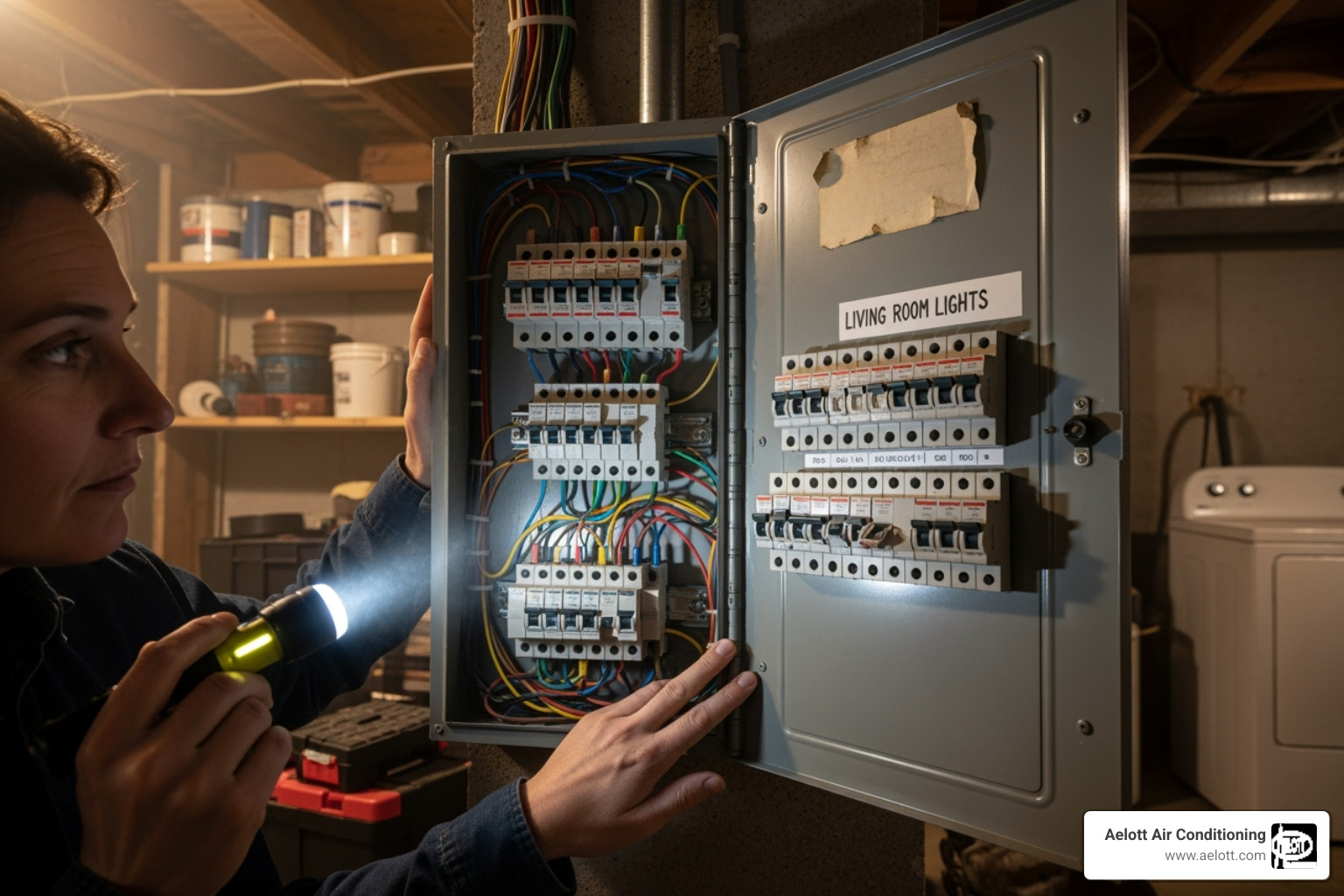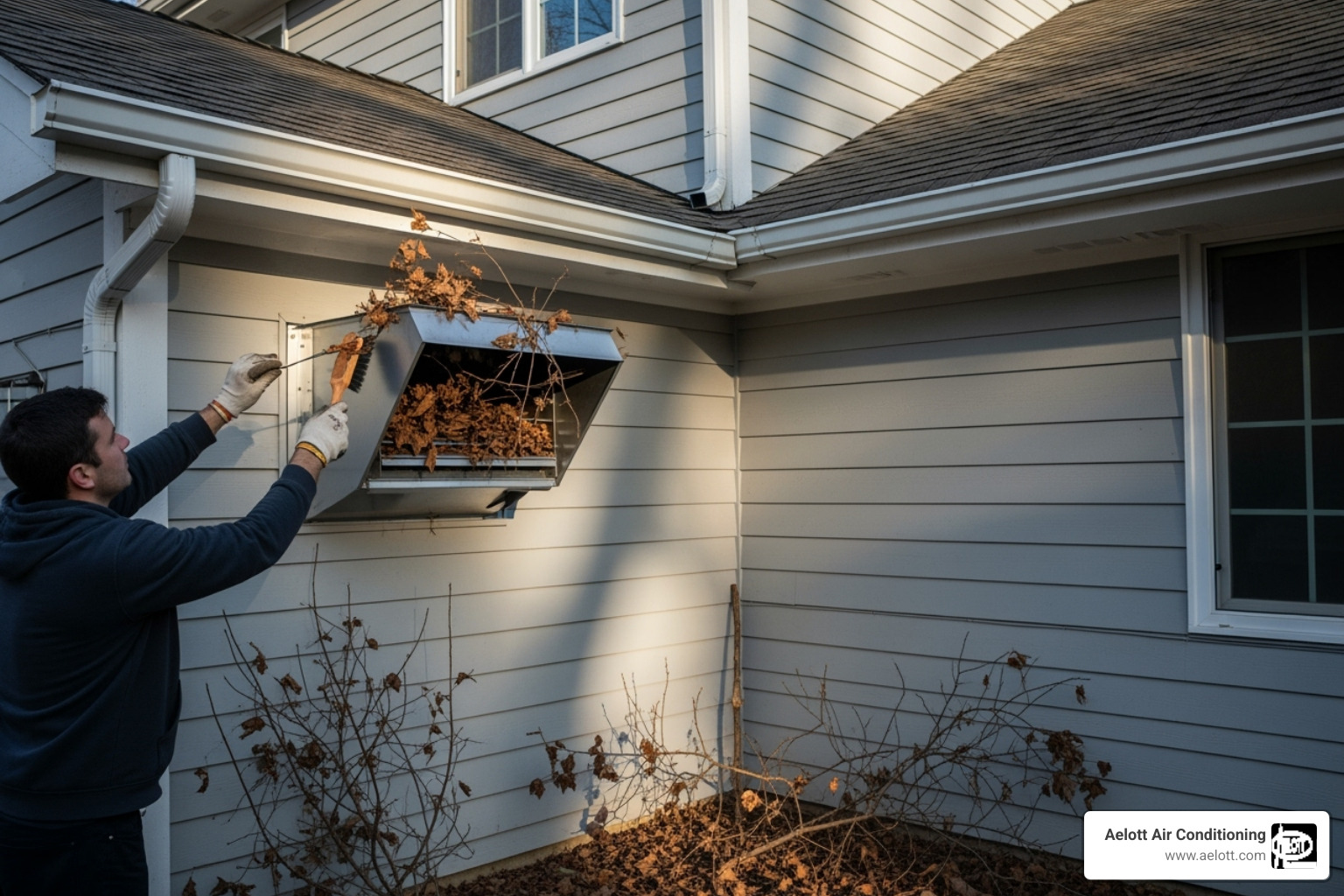.webp)
.webp)
Is Your Heater on Strike? Simple Steps to Reboot Your Furnace
Heater not working? Troubleshoot common furnace issues with DIY checks, safety tips, and expert advice. Get your home warm again!

When Your Heater Not Working Leaves You in the Cold
When your heater not working strikes on a chilly San Diego evening, you don't need to bundle up in blankets and wait for a repair technician. Many furnace problems have simple solutions you can try yourself.
Quick Troubleshooting Checklist for a Non-Working Heater:
- Check your thermostat - Set to "HEAT" mode, temperature above room temp, fresh batteries
- Inspect the air filter - Replace if dirty or clogged (every 1-3 months)
- Verify power supply - Check circuit breaker, furnace power switch, safety switches
- Clear blocked vents - Remove furniture or debris from supply and return vents
- Confirm gas supply - Ensure gas valve is open and parallel to the gas line
According to heating industry data, heating equipment accounts for 14% of all reported home fires, making proper troubleshooting and maintenance critical for both comfort and safety. The good news? Furnace technicians often find that many "broken" heaters simply need to be turned on or have a basic component checked.
Most heater problems fall into a few common categories: thermostat issues, power supply problems, restricted airflow, or gas supply interruptions. Before you spend money on a service call, these simple checks can often get your heat flowing again in minutes.

First-Response Furnace Fixes: Simple DIY Checks
When your home suddenly feels arctic, don't panic. Before calling for service, try these simple first-response fixes that can save you time and money when your heater not working is due to a minor issue.
Thermostat Troubleshooting: Is It Really the Boss?
Your thermostat is the command center of your heating system, and a simple setting error is a common reason for a service call.
First, check the basics. Is the thermostat set to "HEAT" mode? Ensure the temperature is set higher than the current room temperature. Next, check the fan setting. The "ON" setting runs the fan constantly, circulating unheated air and making it seem like your heater is blowing cold. For normal operation, always use the "AUTO" setting, which only runs the fan when the furnace is actively heating.

Dead batteries can disable your thermostat. If the display is blank or unresponsive, replace the batteries. We recommend doing this every fall. Finally, incorrect programming on a programmable thermostat can cause issues. Try overriding the schedule or resetting it to factory settings.
If you notice other odd behaviors, our guide on The Top Signs Your Furnace Needs Maintenance can help you spot potential issues early.
Power Plays: Checking Your Heater's Electrical Supply
A heating system needs electricity to run. If your heater not working is a sudden development, a power issue is a likely culprit.
Locate the furnace power switch, which looks like a standard light switch near your furnace. It can be accidentally flipped off, so ensure it's in the "ON" position.
Next, check your home's circuit breaker panel. Find the breaker labeled "FURNACE," "HEAT," or "HVAC." If it's in the "OFF" or middle "tripped" position, flip it completely off, then firmly back on. Power surges can trip breakers.

Older homes may have fuses; check for any that are blown (broken wire or cloudy glass) and replace them with a fuse of the correct amperage.
Also, check the safety switch on the blower motor panel. The furnace won't run if this panel isn't completely closed. A simple reset procedure can also help: turn off power at the furnace switch and breaker for five minutes, then turn it all back on to clear minor electrical glitches.
Breathe Easy: The Critical Role of Your Air Filter
A clogged air filter can suffocate your furnace, causing it to stop working. This simple component is vital for your system's health.
When the filter is packed with dust and debris, it restricts airflow. The furnace must work harder, which can cause the heat exchanger to overheat. Modern furnaces have a safety feature that shuts the system down to prevent damage, leaving you with a heater not working.
The fix is simple: replace your disposable filter every 1 to 3 months. Change it more often if you have pets, smokers, or allergy sufferers. Some homes may need monthly changes.
When installing a new filter, look for the arrow on the frame. It indicates airflow direction and should always point toward the furnace. Regular filter changes are a small investment that prevents major problems and keeps your system running efficiently. For more tips, see our guide on How to Run Your Furnace Efficiently.
Why Your Heater is Not Working: Common Culprits Revealed
If the simple fixes don't work, your heater not working might be due to a deeper issue. Let's explore other common culprits that don't necessarily mean a major repair.
Initial Checks for a Heater Not Working
Your heater needs fuel to run. For most homes, this is natural gas. Check the gas supply valve near your furnace. The handle should be parallel to the gas line, indicating it's "on." If it's perpendicular, it's off. If you turn it on and smell gas, turn it off immediately and call a professional.
Older furnaces (pre-1990s) use a pilot light, a small, constant flame. If it's out, the furnace won't produce heat. Refer to your owner's manual for relighting instructions. If it won't stay lit, it needs professional service.
Newer furnaces use electronic ignition. If you hear clicking but the burners don't light, or there's just silence, the ignitor or control board may be faulty. For homes with propane or oil, check your fuel levels. Running out of fuel is a common oversight. Your heater needs fuel to run properly, so check your tank gauge.
Clearing the Way: Vents, Flues, and Drains
Proper airflow is essential for your furnace to work. Any blockage can prevent your home from getting warm.
Walk through your home and check all supply and return air vents. Ensure they are not blocked by furniture, rugs, or other items. Restricting airflow by closing vents in unused rooms can harm your furnace and is not an effective way to save energy.
The furnace's exhaust flue vents combustion gases outside. It can be blocked by nests or debris, creating a dangerous carbon monoxide risk and triggering a safety shutdown. If you suspect a blocked flue, turn off the furnace and call a professional immediately.
High-efficiency furnaces have a condensate drain line that can get clogged with algae or sediment. This causes water to back up and trigger a float switch, shutting down the system. You may be able to clear minor clogs by carefully flushing the line, but stubborn blockages require a pro. If you're in Vista, our team provides expert Furnace Service Vista CA.

Advanced Issues Causing Your Heater Not Working
When basic troubleshooting fails, the heater not working problem may be an internal component. These issues typically require a professional.
- Short cycling: The furnace turns on and off frequently without completing a full heating cycle. This is often caused by a dirty flame sensor that can't detect the flame, causing a safety shutdown. An oversized furnace can also cause this. Learn more in our guide on Why HVAC System Short Cycles.
- Faulty ignitor/pilot light: In modern furnaces, a bad ignitor prevents the burners from lighting. You might hear clicking but get no heat. In older units, a pilot light that won't stay lit has the same effect.
- Cracked heat exchanger: This is a serious safety hazard. The heat exchanger separates combustion gases from your breathing air. A crack can leak carbon monoxide into your home. Signs include strange chemical smells or soot around the furnace. If you suspect this, shut off the furnace, open windows, and evacuate.
- Blower motor failure: The furnace may create heat, but a failed blower motor can't push it through the ducts. You'll hear the system run, but no air will come from the vents.
Our experienced technicians have been diagnosing and fixing these issues since 1963, ensuring your system is both comfortable and safe.
Safety First: Why a Broken Heater is More Than an Inconvenience
When your heater not working is the problem, it's easy to focus on the discomfort. However, a malfunctioning heating system can pose serious safety risks to your family.
The Hidden Dangers of a Malfunctioning Heater
- Carbon Monoxide (CO): This invisible, odorless gas is a byproduct of incomplete combustion. A cracked heat exchanger or blocked flue can cause CO to leak into your home. Symptoms of exposure include headaches, dizziness, and nausea, and it can be fatal. Install CO detectors on every level of your home and test them regularly.
- Gas Leaks: If you smell a "rotten egg" odor or hear hissing near your furnace, evacuate the house immediately. Do not use phones or flip switches. Once outside, call your gas company, then a professional HVAC technician.
- Fire and Electrical Hazards: According to federal data, heating equipment is a leading cause of home fires. Overheating from clogged filters, frayed wiring, or other electrical faults can create a significant fire risk.
Understanding these dangers helps you know when to call a professional for a heater not working instead of attempting a risky DIY fix.
The Power of Prevention: How Maintenance Saves the Day
The best way to avoid a heater not working emergency is with preventative maintenance. An annual tune-up is the most effective defense against unexpected breakdowns and safety hazards.
During a tune-up, a technician will clean and inspect your entire system. This proactive care improves component longevity, improves energy efficiency by ensuring the system runs smoothly, and, most importantly, prevents breakdowns on the coldest days. Technicians check safety controls, clean critical parts, and look for wear and tear on components like the heat exchanger.
Following a yearly maintenance checklist ensures your system runs safely and efficiently. Our Heating Services in Escondido CA team can help prepare your system for winter, keeping your home warm and safe.
Calling in the Cavalry: When to Contact an HVAC Professional
While many issues can be solved with DIY troubleshooting, some problems require the specialized tools and expertise of a trained HVAC technician. Knowing when your heater not working requires a professional call is key to preventing further damage and ensuring your family's safety.
Contact a professional immediately if you experience any of the following:
- You smell gas: If you detect a "rotten egg" odor, evacuate your home immediately. From a safe location, call your gas company first, then an HVAC professional. Do not attempt to fix this yourself.
- Loud or unusual noises: Banging, grinding, or screeching sounds often indicate a serious mechanical problem, such as a failing blower motor or loose parts, that can cause significant damage if ignored.
- Persistent electrical issues: If your circuit breaker repeatedly trips after being reset, it signals an underlying electrical fault that could be a fire hazard.
- Water pooling around the furnace: While some condensation is normal for high-efficiency units, excessive water can indicate a clogged drain line or a more serious internal leak, leading to water damage or mold.
- DIY fixes don't work: If you've gone through the basic troubleshooting checklist—thermostat, filter, power, and vents—and your heater is still not working, it's time to call for professional diagnostics.
- Carbon monoxide concerns: If your CO detector alarms or anyone in the house has symptoms of CO exposure (headaches, dizziness, nausea), treat it as an emergency. Evacuate and call for help.
Our NATE-certified technicians have been solving heating problems since 1963. For expert Heating Repair San Marcos CA, don't hesitate to reach out for safe and reliable service.
Frequently Asked Questions about Heater Problems
When you have a heater not working, you're bound to have questions. With our experience dating back to 1963, we've heard them all. Here are answers to the most common ones.
Why is my heater blowing cold air?
This is a frustrating but common issue. Here are the most likely causes:
- Thermostat Fan Setting: Your fan is likely set to "ON" instead of "AUTO." The "ON" setting runs the fan constantly, even when the furnace isn't heating, circulating room-temperature air. Switch it to "AUTO."
- Overheating Furnace: A severely clogged air filter can restrict airflow, causing your furnace to overheat. The burners will shut off for safety, but the fan may continue to run to cool the unit down, blowing unheated air.
- Pilot Light is Out: On older furnaces, the pilot light must be lit for the burners to ignite. If it's out, the fan may run but no heat will be produced.
- Leaky Ductwork: Heated air could be escaping from disconnected or leaky ducts in your attic or crawlspace before it reaches your vents.
How often should I really change my furnace filter?
The standard advice is every 1 to 3 months, but the ideal frequency depends on your home.
- Change monthly if you have pets, smokers, or family members with allergies, as more particles are circulating in the air.
- Check visually every month. Hold the filter up to a light. If you can't see light through it, it's time for a new one, regardless of how long it's been. A clean filter is crucial for airflow and system health. Always use a filter type recommended by your furnace manufacturer.
What does it mean if my furnace keeps turning on and off?
This is called short cycling, and it indicates an underlying problem that wastes energy and puts stress on your system. Common causes include:
- A dirty flame sensor: This safety device gets coated in soot and can't detect the flame, causing it to shut down the system repeatedly.
- A clogged air filter: This leads to overheating, which triggers the safety switches to turn the furnace off. The system then cools down and tries to start again.
- An oversized furnace: The unit heats the space too quickly and shuts off before completing a proper cycle.
- Thermostat location: If your thermostat is near a heat source (lamp, direct sunlight) or in a draft, it can get inaccurate readings and cycle the furnace incorrectly.
Addressing short cycling quickly can prevent more serious damage. For more seasonal tips, see our guide on Heating System Problems to Look Out For This Winter.
Conclusion: Get Your Home Warm and Toasty Again
When your heater not working leaves you bundled up in blankets, you're not completely helpless. We've walked through the most common culprits together – from thermostat hiccups and power interruptions to clogged filters and blocked vents. These simple fixes can often restore warmth to your home in just minutes.
The beauty of these troubleshooting steps is their simplicity. Checking your thermostat settings ensures your system knows what you want. Verifying your power supply confirms your furnace has the juice to run. Replacing that dirty air filter lets your system breathe again. Ensuring proper gas flow gives your furnace the fuel it needs. Clearing blocked vents and drain lines removes the obstacles preventing efficient operation.
But here's what matters most: your safety always comes first. If you smell gas, hear concerning noises, or suspect something serious like a cracked heat exchanger, don't try to be a hero. Step back and call the professionals immediately. Some problems are simply too dangerous to tackle on your own.
That's where we come in. Since 1963, Aelott Air Conditioning has been the trusted heating expert for families throughout Escondido, Carmel Mountain, Del Mar, Vista, Oceanside, Carlsbad, San Marcos, and Poway. We've built our reputation on honest pricing, reliable service, and our 100% satisfaction guarantee. When your DIY efforts hit a wall, or when safety concerns arise, our experienced technicians have the tools and expertise to get your heat flowing safely again.
Don't spend another night shivering under extra blankets. Whether it's a simple fix that's stumped you or a complex issue requiring professional diagnosis, we're here to help restore comfort to your home.
Ready to get cozy again? Schedule professional heating repair in Escondido today and let us bring the warmth back where it belongs – throughout your entire home.

Customer Testimonials
Go With Experience

HVAC Financing Available!
Get 0% Financing for 12 Months with Deferred Interest! Enjoy no payments and no interest on select plans.


Latest Blogs

.avif)
How to Run Your Furnace Efficiently: A Guide to Staying Warm This Winter







